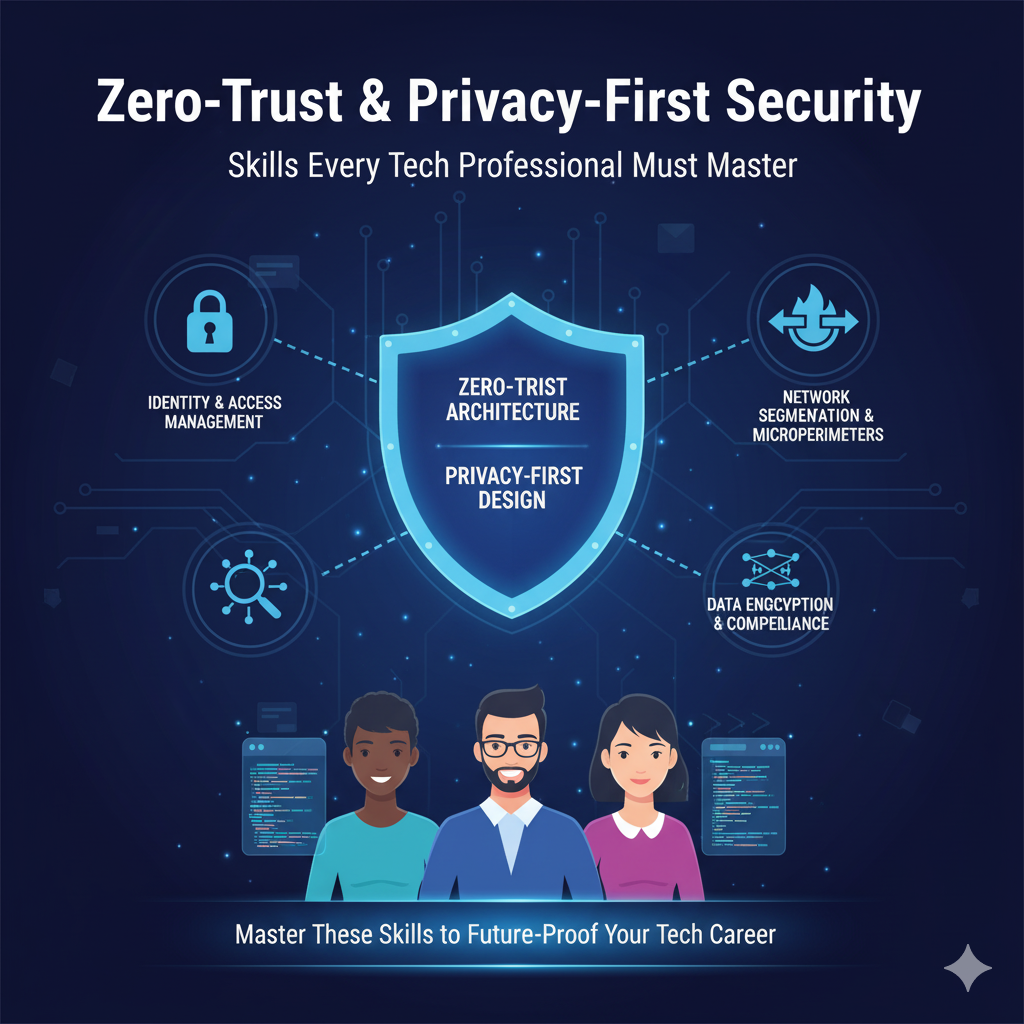
Zero-Trust & Privacy-First Security: Skills Every Tech Professional Must Master
In an age of streaming data, cloud workloads, and borderless networks, security and privacy are no longer sidelines — they’re the backbone of trust. Zero-Trust and privacy-first models are leading that shift. For tech professionals in 2025, mastering these frameworks is not optional — it’s essential.
🔍 What Are Zero-Trust & Privacy-First Security?Zero-Trust Security operates on the principle: never trust, always verify. Every request — internal or external — must be authenticated, authorized, and validated continuously. [CrowdStrike: What is Zero Trust?] [Trend Micro: What is Zero Trust Architecture?]
Meanwhile, Privacy-First Security emphasizes handling user data with intent, complying with regulations, and embedding privacy controls (minimization, anonymization, consent) from design (Privacy by Design).
These models guard against threats created by remote work, hybrid infrastructure, and AI systems that process sensitive data.
🚀 Why the Urgency in 2025?-
The Zero-Trust market is booming: projected to hit USD ~$92.4 billion by 2030, growing at ~16.6 % CAGR. [Grand View Research: Zero Trust Market]
-
Enterprises adopting Zero-Trust are boosting resilience against lateral attacks and insider threats. [Dark Reading: NIST Examples]
-
Privacy regulations are tightening globally — new data protection laws, AI governance rules, and region-specific compliance demands. [Forbes: Role of Data Governance]
-
In 2025, privacy and AI governance are converging. The boundary between “security” and “data ethics” is blurring. [AI Data Analytics: Trends Shaping Data Privacy 2025]
This means businesses expect professionals who understand not just how to defend systems, but how to build them in privacy-aware, regulation-compliant ways.
🧰 Skills Tech Professionals Must Master-
Identity & Access Management (IAM) & Zero-Trust Core Architecture
Understand multi-factor authentication (MFA), single sign-on (SSO), role-based & attribute-based access, continuous verification.
Get familiar with Zero-Trust architectures and principles. [Palo Alto Networks: What Is Zero Trust Architecture?] -
Encryption, Tokenization & Secure Data Handling
Data encryption at rest, in motion; use tokenization, masking, pseudonymization; secure APIs and data transfers. -
Data Governance, Privacy Regulations & Compliance
Skills in GDPR, CCPA, HIPAA; designing data policies, consent frameworks, audits.
Learn data governance best practices. [DATAVERSITY: 2025 Data Governance Best Practices] -
Continuous Monitoring, Threat Detection & Auditing
Implement logs, SIEM, anomaly detection, intrusion detection, regular audits, incident response planning. -
Network Microsegmentation & Least-Privilege Design
Partition networks into zones to limit lateral movement; use context-aware controls (device, location, time) for access. -
Ethical & Privacy-Aware Design (Privacy by Design)
Incorporate privacy early in system design, perform privacy impact assessments, bias mitigation in AI. -
Soft Skills: Communication, Policy Writing, Stakeholder Engagement
You’ll need to coordinate between tech, legal, and business teams; translate security/privacies into business context.
-
Privacy & Compliance Learning Paths — Deep dives into GDPR, CCPA, AI privacy policies
-
Zero-Trust & IAM Modules — From authentication to microsegmentation
-
Data Governance & Secure System Design Courses
These internal resources help you not just earn certificates, but gain practical competency for modern security roles.
Tags :
- Zero Trust
- Cybersecurity
- Data Privacy
- Information Security
- Data Governance
- Privacy First
- Compliance Training
- ChronoLearn
- AI Security
- Security Skills
- Zero Trust architecture training 2025
- Privacy-first security best practices
- Data governance and compliance courses
- Skills for cybersecurity professionals in 2025
- GDPR and AI governance training
- Zero Trust vs traditional security
- Future of privacy-first design
- Security certifications for IT professionals
- Cloud and data protection skills
- Enterprise cybersecurity strategy 2025






